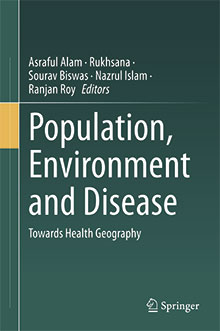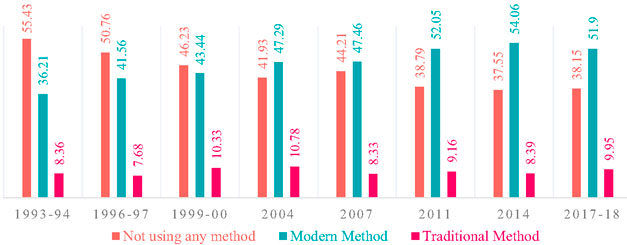|

|
POPULATION, ENVIRONMENT AND
DISEASE
Editors: Asraful Alam, Rukhsana, Sourav Biswas,
Nazrul Islam, Ranjan Roy
Springer Cham, 2024, 364 pages
|
https://link.springer.com/book/10.1007/978-3-031-67624-6#overview
|
Наше исследование предоставляет первые оценки
потери производительности труда, связанной с преждевременной
смертностью от рака в индийской экономике. Согласно исследованию,
в 2022 году Индия потратила 12,2 млрд долларов США, или 0,36%
своего ВВП, на потерю производительности труда в результате
ранней смерти от рака. Значительные различия в структуре бремени
онкологических заболеваний в Индии, измеряемого по потерянной
производительности, подчеркивают необходимость разработки
региональных целей и методов борьбы с раком. Этот экономический
взгляд на бремя онкологических заболеваний в развивающихся
странах улучшает уже имеющиеся индексы здоровья населения.
Мы обращаем внимание на необходимость учета влияния рака на
производительность труда, которая является критическим фактором,
определяющим будущий рост и процветание Индии.
Страница 57

Тенденция распространенности контрацепции в Бангладеш,
1993-2018 гг. (в процентах) (стр. 270)
|
В книге рассматривается широкий круг жизненно важных
вопросов общественного здравоохранения в регионах Южной Азии, охватывающих
учреждения здравоохранения, систему здравоохранения, заболевания
и эпидемиологический переход, пространственно-временные изменения
в учреждениях здравоохранения, модели заболеваемости и сложные взаимосвязи
между здоровьем человека и окружающей средой. Книга состоит из трёх
основных разделов: социально-демографические детерминанты общественного
здравоохранения и политики; пространственно-временные и экологические
детерминанты общественного здравоохранения и политики; и эпидемии
заболеваний и проблемы. Главы охватывают широкий спектр тем, связанных
с пространством и здоровьем, которые носят многомерный и междисциплинарный
характер, начиная от систематического обзора литературы, библиометрического
анализа экологических проблем, оценки финансового бремени, исследования
эффективности программ, поведения, направленного на сохранение здоровья,
в контексте проблем женского здоровья, недавних чрезвычайных ситуаций
в области здравоохранения и поведения людей, поведения в отношении
рождаемости, мультиморбидности пожилых людей и питания, которые
являются некоторыми из интересных областей, исследуемых на макро-
и микроуровне с использованием крупномасштабных данных из открытых
источников или путем сбора подробных данных на местном уровне.
Contents
Part I History, Evolution, and Trends of Health Geography
1 Development of Health and Medical Geography: A Systematic Review
Nazrul Islam, Asraful Alam, Amiya Basak, Uttam Das, and Rukhsana
1.1 Introduction
1.2 Methods
1.2.1 Selection of the Research Articles
1.2.2 Identification of Themes in Health Geography
1.3 Evolution and Development in Health Geography
1.3.1 Evolution and Development in Health Geography During 1980-1990
1.3.2 Evolution and Development in Health Geography During 1991-2000
1.3.3 Evolution and Development in Health Geography During 2001-2010
1.3.4 Evolution and Development in Health Geography During 2011-2020
1.4 Challenges and Opportunities in Health Geography
1.4.1 Challenges and Opportunities in Health Geography
1.4.2 Opportunities in Health Geography
1.5 Conclusions
References
2 Global Trend of Environmental Health Research: A Comprehensive
Bibliometric Analysis
Sourav Biswas, Prosenjit Barman, and Asraful Alam
2.1 Introduction
2.2 Methodology
2.3 Results
2.3.1 Main Information: Annual Publication Growth
2.3.2 Annual Publication Growth
2.3.3 Analysis of Journals, Institutions, Authors, and Countries
2.3.4 Most Frequent Keywords and Their Co-occurrence Network
2.3.5 Multiple Correspondence Analysis
2.4 Discussion
2.5 Conclusion
References
3 Assessing the Financial Burden: A Comprehensive Study of Cancer-Related
Premature Mortality and Its Effects on India's Economic Productivity
Koushik Roy Pramanik and Murali Dhar
3.1 Introduction
3.2 Methods
3.2.1 General Approach
3.2.2 Data Sources
3.2.3 Data Analysis
3.2.4 Sensitivity Analyses
3.3 Results
3.3.1 Total Productivity Losses and Losses per Death
3.3.2 Sex-Specific Lost Productivity
3.3.3 Productivity Cost by Leading Cancer Sites
3.3.4 Sensitivity Analyses
3.4 Discussion
3.5 Conclusions
References
4 Inattention Diminishment and Health Geography: An Analysis on
Elementary to Higher Secondary Students
Divyadyuti Banerjee, Swaagat Ray, Anujit Patra, Arumay Jana,
and Subarna Bhattacharyya
4.1 Introduction
4.2 Data and Methodology
4.2.1 Data Source
4.2.2 Methodology
4.3 Results and Discussion
4.3.1 Results
4.3.2 Discussion
4.4 Conclusion
References
5 Utilisation and Accessibility of Healthcare Services Among Gig
Workers: A Systematic Review
Pooja Kalbalia, Nayan Jyoti Nath, and K. V. Haneefa
5.1 Introduction
5.2 Identification of Objectives
5.3 Methodology
5.4 Data Analysis
5.5 Inclusion and Exclusion Criteria
5.6 Integration of Gig Workers into Healthcare Systems
5.7 Gig Workers' Health: Socio-Demo Dynamics
5.8 Occupational Health and Safety Concerns in the Gig Economy
5.9 Mental Health and Well-Being in the Gig Economy
5.10 Impact of COVID-19 on Gig Workers' Health
5.11 Strengths and Limitations
5.12 Conclusion
References
Part II Community Health Dynamics and Practices
6 Rashtriya Swasthya Bima Yojana (RSBY) Availing Among Middle and
Old Age Migrants: A Study of National Health Insurance Programme
in India
Jadab Munda and Ajay Murmu
6.1 Introduction
6.2 Methods
6.2.1 Data
6.2.2 Study Sample
6.3 Variables Description
6.3.1 Outcome Variable
6.3.2 Key Explanatory Variables
6.3.3 Other Covariates
6.4 Statistical Analysis
6.5 Results
6.6 Discussion
6.7 Conclusion
References
7 HIV/AIDS in Village India: Issues and Challenges
Ananya Guha Roy
7.1 Introduction
7.1.1 HIV Prevalence by States in India
7.2 Methodology of Data Collection
7.3 Result
7.3.1 Profile of the Respondents
7.3.2 Various Challenges
7.4 Discussion
7.5 Conclusion
References
8 Determining the Associated Factors of Mothers' Healthcare-Seeking
Behaviour for Common Childhood Morbidity Among Tribal and Non-tribal
Communities in India Using Andersen's Behavioural Model
Astapati Hemram and Dipika Subba
8.1 Introduction
8.2 Material and Methods
8.2.1 Data Source
8.2.2 Outcome Variables
8.2.3 Explanatory Variables
8.2.4 Statistical Analysis
8.3 Results
8.3.1 Background Characteristics of Study Participants
8.3.2 Tribal and Non-tribal Differences in the Healthcare-Seeking
Behaviour for Childhood Illnesses by Background Characteristics
8.3.3 Factors Associated with Healthcare-Seeking Behaviour for
Childhood Illnesses Among Tribal and Non-tribal Women
8.4 Discussion
8.5 Limitations of the Study
8.6 Conclusion
References
9 A Cross-Sectional Study of the Knowledge, Perceptions, and Practices
of Menstrual Hygiene Among College Students
Bhupen Barman
9.1 Introduction
9.2 Statement of the Problem
9.3 Review of the Literature
9.4 Scope of the Study
9.5 Objective
9.6 Materials and Methods
9.7 Result and Discussions
9.7.1 Socio-demographic Characteristics
9.7.2 Knowledge and Perceptions of Students on Menstruation
9.7.3 Obstetric- and Gynaecological-Related Characteristics
9.7.4 Menstrual Hygiene Practices of College Students
9.7.5 Awareness of Menstruation of College Students
9.7.6 Limitations of Study
9.8 Conclusions
References
10 Effects of COVID-19 on Street Vendors of Suti-I and Suti-II
C.D. Blocks of Murshidabad District, West Bengal
Koushik Kumar Das
10.1 Introduction
10.2 Objectives
10.3 Database and Methodology
10.3.1 Pre-field
10.3.2 Field
10.3.3 Post-field
10.4 Study Area
10.5 Demographic Status
10.6 Street Vendors and the Economy
10.6.1 Occupational Structure of the Street Vendors
10.6.2 Working Hours per Day and Month
10.6.3 Monthly Income of the Street Vendors
10.6.4 Working Population of the Street Vendors' Families
10.6.5 Reasons for Choosing Vending
10.7 Street Vendors and Social Life
10.7.1 Level of Satisfaction About the Street Vendors' Professional
Life After COVID-19
10.7.2 Location of Street Vendors' Working Place
10.8 Street Vendors and Health Conditions
10.8.1 Medical Treatment
10.9 Condition of the Business Regarding COVID-19
10.10 Occupation Transformation to Beedi Workers
10.11 Major Findings
10.12 Major Problems for Street Vendors due to COVID-19
10.13 Suggestions to Improve Socio-economic Conditions
10.14 Conclusion
References
11 Prevalence and Correlates of Menstrual Irregularities Among
Young Women in India: Findings from the Fifth Round National Family
Health Survey
Swagata Karjee and Prites Chandra Biswas
11.1 Introduction
11.2 Data and Methods
11.2.1 Data
11.2.2 Outcome Variables
11.2.3 Statistical Analysis
11.3 Results and Discussion
11.3.1 Background Characteristics of Women
11.3.2 Prevalence of Menstrual Irregularities in India
11.3.3 Prevalence of Menstrual Irregularities by Background Characteristics
of Women
11.3.4 Likelihood of Menstrual Irregularities by Background Characteristics
of Women
11.4 Conclusion
References
Part III Social, Economic and Environmental Determinants
of Health
12 Prevalence, Pattern, and Predictors of Multi-morbidity Among
India's Elderly Population
Mihir Adhikary, Amiya Saha, and Kailash Chandra Das
12.1 Introduction
12.2 Data and Methods
12.2.1 Sample Design and Sample Size
12.2.2 Variable Description
12.2.3 Analytical Approach
12.3 Results
12.3.1 Descriptive Information of Respondents
12.3.2 Results from the Bivariate Analysis
12.3.3 Results from the Multivariate Analysis
12.4 Discussion
12.4.1 Strengths and Limitations
12.5 Conclusion
References
13 Demographic and Socioeconomic Determinants of Indigenous Tribal
Fertility Behaviour: A Case Study of Dinhata-II Block of Cooch Behar
District, West Bengal
Bishnu Barman, Tamal Basu Roy, Bappa Sarkar, and Ranjan Roy
13.1 Introduction
13.2 Objectives of the Study
13.3 Database
13.4 Methodology
13.4.1 Chi-Square Analysis
13.4.2 Multiple Regression Analysis
13.5 Result and Discussion
13.5.1 Demographic Determinants of Fertility
13.5.2 Social Determinants of the Tribal Fertility
13.5.3 Economic Determinants
13.6 Conclusion
References
14 Fostering Employee Mental Health: Role of HRM Practices in Unicorn
Startups
Chanchal Dey and Debasish Biswas
14.1 Introduction
14.2 Literature Review
14.3 Research Methods
14.4 Results and Discussion
14.5 Limitations of Study and Scope of Future Research
14.6 Conclusion
References
15 Determinants of Wasting Among Under-Five Children in Tea Gardens
of Kalimpong-Darjeeling Region: A Multilevel Analysis
Diksha Chettri and Dipika Subba
15.1 Introduction
15.2 Methodology
15.3 Results
15.3.1 Background Characteristics of the Study Area
15.4 Wasting Children by Background Characteristics
15.5 Risk Factors Associated with Wasting Among Children in the
Study Area
15.6 Discussion
15.7 Conclusion and Limitations
References
16 Sociodemographic Determinants of Desired Fertility Among Women
Working in Formal Sectors in Abuja, Nigeria
Iwalaiye Elizabeth Mayokun and Bala Dogo
16.1 Introduction
16.2 The Statement of the Problem
16.3 Research Questions
16.4 Materials and Methods
16.5 Results and Discussions
16.5.1 Sociodemographic Determinants of Desired Fertility
16.6 Conclusions
16.7 Policy Recommendations
References
17 Unpacking Traditional Contraceptive Practices in Bangladesh:
A Comprehensive Examination of Nationally Representative Large-Scale
Data
Mihir Adhikary, Kailash Chandra Das, Nazrul Islam, Moslem Hossain,
Manoj Dakua, and Manoj Debnath
17.1 Background
17.1.1 Why Do Women Prefer the Traditional Method of Contraception?
17.1.2 Importance of Studying Traditional Contraceptive Method
Use in Bangladesh
17.2 Data and Methods
17.2.1 Data Source
17.2.2 Variable Description
17.2.3 Statistical Analysis
17.3 Results
17.4 Discussion
17.4.1 Strength and Limitations
17.5 Conclusion
References
18 Practice of Female Sterilization Among Currently Married Women
in West Bengal, India: Trends and Magnitude of Differentials
Susanta Sen, Amit Banerjee, Asif Ali, and Namita Chakma
18.1 Introduction
18.2 The Data
18.3 Variables
18.4 Results and Discussion
18.4.1 Trends of Female Sterilization Practice in West Bengal
and India
18.4.2 District-wise Differentials of Female Sterilization Practice
in West Bengal
18.4.3 Socioeconomic and Demographic Differentials of Female Sterilization
Practice in West Bengal
18.5 Necessary Policy Interventions
18.6 Conclusion
References
19 Determinants of Institutional Delivery in West Bengal: Findings
from NFHS-5 (2019-21)
Sangita Karmakar, Punama Sen, Barnali Biswas, Tanushree Sikdar,
and Ranjan Roy
19.1 Introduction
19.2 Objectives
19.3 Methodology
19.3.1 Data Source
19.3.2 Dependent Variable
19.3.3 Independent Variable
19.3.4 Statistical Analysis
19.4 Analysis
19.4.1 Results
19.4.2 Determining Factors of Institutional Delivery in West Bengal
19.5 Discussion
19.6 Spatial Pattern of Institutional Delivery in West Bengal
19.7 Conclusion
References
20 Rural-Urban Differential Use of Cooking Fuel and Its Association
with Women's Nutritional Health and Child's Birth Weight
Biswajit Dandapat, Amrita Paul, Bubun Mahata, and Banasri Patra
20.1 Introduction
20.1.1 Background
20.1.2 Statement of Problem
20.1.3 Objectives of the Study
20.1.4 Rational of the Study
20.2 Database and Methodology
20.2.1 Database
20.2.2 Outcome Variables
20.2.3 Explanatory Variables
20.2.4 Confounding Variables
20.2.5 Methods
20.3 Result
20.3.1 Trend and Pattern of Using Nature of Cooking Fuels in India
at the Household Level
20.3.2 Impact of Nature and Various Types of Cooking Fuels on
Women's Nutritional Health (BMI)
20.3.3 Association Between Nature and Various Types of Cooking
Fuels with Women's Nutritional Health (BMI)
20.3.4 Impact of Nature and Various Types of Cooking Fuels on
Child's Birth Weight
20.3.5 Association Between Nature and Various Types of Cooking
Fuels on Child's Birth Weight
20.4 Discussion
20.5 Conclusion
References
21 Waterborne Health Risks in Cooch Behar Municipality, West Bengal,
India: A Study of Water Usage, Treatment, and Sanitation Practices
Bappa Sarkar
21.1 Introduction
21.2 Methodology
21.2.1 Study Area
21.2.2 Data Collection
21.2.3 Data Analysis
21.3 Result and Discussion
21.3.1 Urban Water Use
21.3.2 Sanitation and Wash Practice
21.3.3 Waterborne Disease
21.4 Conclusion
References
|

